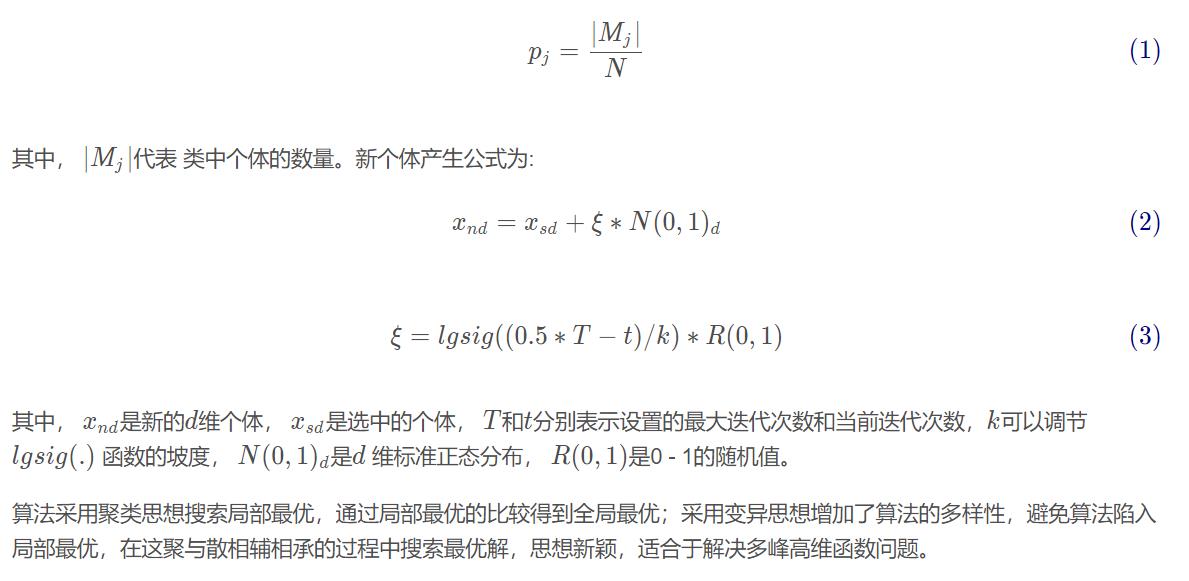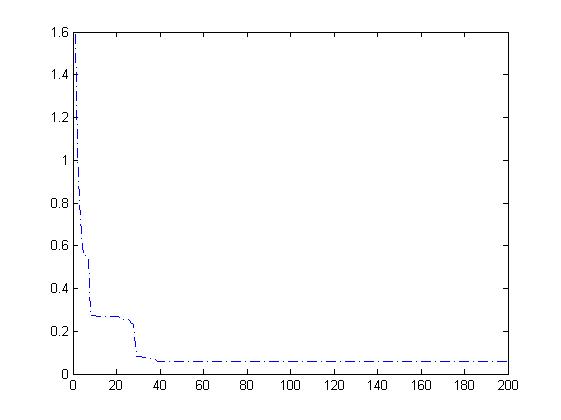优化算法头脑风暴优化算法(BSO)含Matlab源码 497期
Posted 紫极神光(Q1564658423)
tags:
篇首语:本文由小常识网(cha138.com)小编为大家整理,主要介绍了优化算法头脑风暴优化算法(BSO)含Matlab源码 497期相关的知识,希望对你有一定的参考价值。
一、简介
1 算法原理
头脑风暴优化算法主要由聚类和变异组成。
1.1 聚类
聚类:BSO采用K-means聚类算法,将相似的个体聚成k类,并将人为设定的适应度函数值最优的个体作为聚类的中心。当然,为了避免陷入局部最优,将有概率随机产生一个新个体替换其中
一个聚类中心。
1.2 变异
BSO变异主要有4种方式,分别是:(a)在随机一个类中心,即该类最优个体上添加随机扰动产生新的个体;(b)在随机一个类中随机选择一个个体添加随机扰动产生新的个体;©随机融合两个类中心,并添加随机扰动产生新的个体;(d)随机融合两个类中随机的两个个体,并添加随机扰动产生新的个体。
上述4种方式每个聚类中心,即类中最优个体
被选中的概率为:

2 算法流程

二、源代码
function best_fitness = bso2(fun,n_p,n_d,n_c,rang_l,rang_r,max_iteration)
% fun = fitness_function
% n_p; population size
% n_d; number of dimension
% n_c: number of clusters
% rang_l; left boundary of the dynamic range
% rang_r; right boundary of the dynamic range
prob_one_cluster = 0.8; % probability for select one cluster to form new individual;
stepSize = ones(1,n_d); % effecting the step size of generating new individuals by adding random values
popu = rang_l + (rang_r - rang_l) * rand(n_p,n_d); % initialize the population of individuals
popu_sorted = rang_l + (rang_r - rang_l) * rand(n_p,n_d); % initialize the population of individuals sorted according to clusters
n_iteration = 0; % current iteration number
% initialize cluster probability to be zeros
prob = zeros(n_c,1);
best = zeros(n_c,1); % index of best individual in each cluster
centers = rang_l + (rang_r - rang_l) * rand(n_c,n_d); % initialize best individual in each cluster
centers_copy = rang_l + (rang_r - rang_l) * rand(n_c,n_d); % initialize best individual-COPY in each cluster FOR the purpose of introduce random best
best_fitness = 1000000*ones(max_iteration,1);
fitness_popu = 1000000*ones(n_p,1); % store fitness value for each individual
fitness_popu_sorted = 1000000*ones(n_p,1); % store fitness value for each sorted individual
indi_temp = zeros(1,n_d); % store temperary individual
%**************************************************************************
%**************************************************************************
% calculate fitness for each individual in the initialized population
for idx = 1:n_p
fitness_popu(idx,1) = fun(popu(idx,:));
end
while n_iteration < max_iteration
cluster = kmeans(popu, n_c,'Distance','cityblock','Start',centers,'EmptyAction','singleton') % k-mean cluster
% clustering
fit_values = 100000000000000000000000000.0*ones(n_c,1); % assign a initial big fitness value as best fitness for each cluster in minimization problems
number_in_cluster = zeros(n_c,1); % initialize 0 individual in each cluster
for idx = 1:n_p
number_in_cluster(cluster(idx,1),1)= number_in_cluster(cluster(idx,1),1) + 1;
% find the best individual in each cluster
if fit_values(cluster(idx,1),1) > fitness_popu(idx,1) % minimization
fit_values(cluster(idx,1),1) = fitness_popu(idx,1);
best(cluster(idx,1),1) = idx;
end
end
best
% form population sorted according to clusters
counter_cluster = zeros(n_c,1); % initialize cluster counter to be 0
acculate_num_cluster = zeros(n_c,1); % initialize accumulated number of individuals in previous clusters
for idx =2:n_c
acculate_num_cluster(idx,1) = acculate_num_cluster((idx-1),1) + number_in_cluster((idx-1),1);
end
%start form sorted population
for idx = 1:n_p
counter_cluster(cluster(idx,1),1) = counter_cluster(cluster(idx,1),1) + 1 ;
temIdx = acculate_num_cluster(cluster(idx,1),1) + counter_cluster(cluster(idx,1),1);
popu_sorted(temIdx,:) = popu(idx,:);
fitness_popu_sorted(temIdx,1) = fitness_popu(idx,1);
end
% record the best individual in each cluster
for idx = 1:n_c
centers(idx,:) = popu(best(idx,1),:);
end
centers_copy = centers % make a copy
if (rand() < 0.2) % select one cluster center to be replaced by a randomly generated center
cenIdx = ceil(rand()*n_c);
centers(cenIdx,:) = rang_l + (rang_r - rang_l) * rand(1,n_d);
end
% calculate cluster probabilities based on number of individuals in
% each cluster
for idx = 1:n_c
prob(idx,1) = number_in_cluster(idx,1)/n_p;
if idx > 1
prob(idx,1) = prob(idx,1) + prob(idx-1,1);
end
end
% generate n_p new individuals by adding Gaussian random values
for idx = 1:n_p
r_1 = rand(); % probability for select one cluster to form new individual
if r_1 < prob_one_cluster % select one cluster
r = rand();
for idj = 1:n_c
if r < prob(idj,1)
if rand() < 0.4 % use the center
indi_temp(1,:) = centers(idj,:);
else % use one randomly selected cluster
indi_1 = acculate_num_cluster(idj,1) + ceil(rand() * number_in_cluster(idj,1));
indi_temp(1,:) = popu_sorted(indi_1,:);
end
break
end
end
else % select two clusters
% pick two clusters
cluster_1 = ceil(rand() * n_c);
indi_1 = acculate_num_cluster(cluster_1,1) + ceil(rand() * number_in_cluster(cluster_1,1));
cluster_2 = ceil(rand() * n_c);
indi_2 = acculate_num_cluster(cluster_2,1) + ceil(rand() * number_in_cluster(cluster_2,1));
tem = rand();
if rand() < 0.5 %use center
indi_temp(1,:) = tem * centers(cluster_1,:) + (1-tem) * centers(cluster_2,:);
else % use randomly selected individuals from each cluster
indi_temp(1,:) = tem * popu_sorted(indi_1,:) + (1-tem) * popu_sorted(indi_2,:);
end
end
%Griewank
function z = griewank(x)
% unimodal optimum 0
[m,n]=size(x);
for j=1:m
for e=1:n
f1(e)=x(j,e)^2;
f2(e)=cos(x(j,e)/sqrt(e));
end
三、运行结果

四、备注
版本:2014a
以上是关于优化算法头脑风暴优化算法(BSO)含Matlab源码 497期的主要内容,如果未能解决你的问题,请参考以下文章